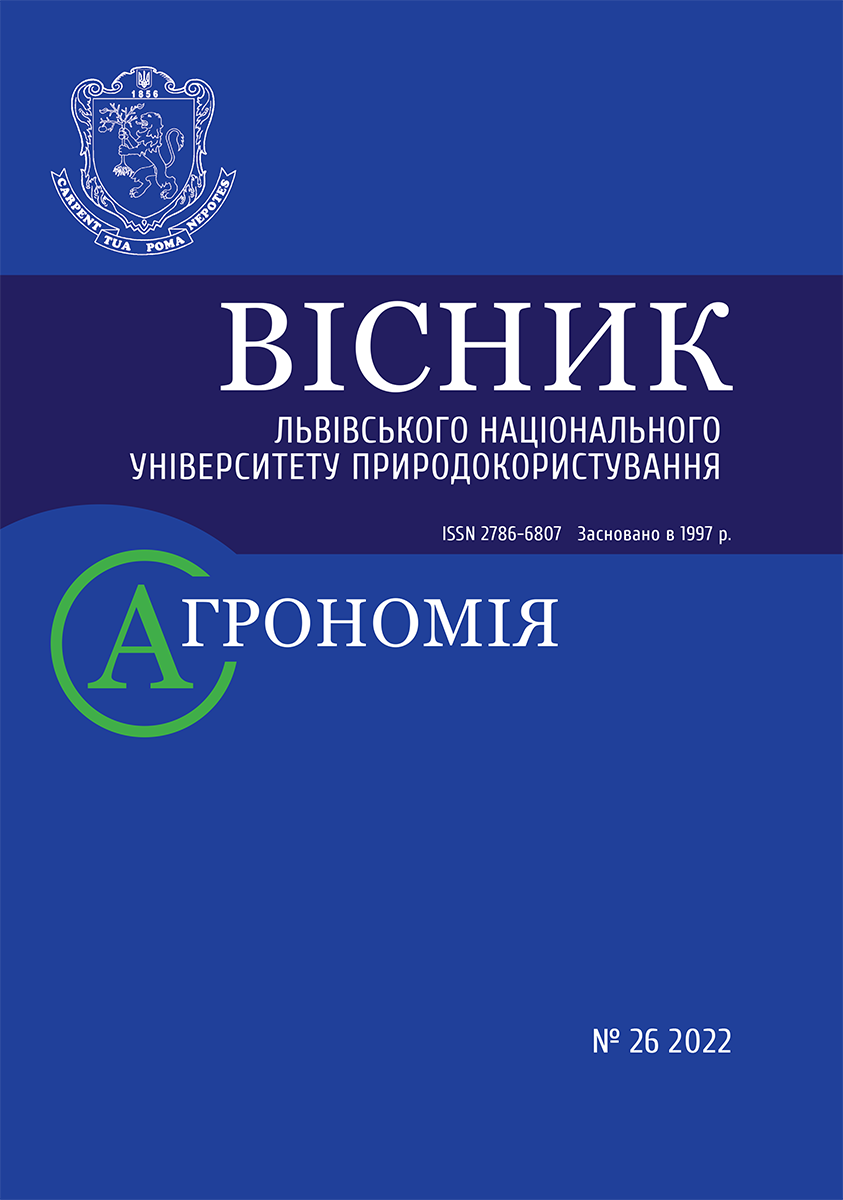BUFFER CURVES AND INDICATORS OF ACID-BASE BUFFERING OF BROWN PODZOLIC SOILS OF EASTERN CARPATHIAN FOOTHILLS UNDER DIFFERENT TERRAINS
DOI:
https://doi.org/10.31734/agronomy2022.26.163Keywords:
brown podzolic soil, acid-base buffering of the soil, buffer curve, neutralization index, acid-base state of the soil, neutralizing capacity of the soil, gradient, acid load, alkaline loadAbstract
Indicators of the acid-base buffer capacity of brown earth-podzolic soil of Eastern Carpathian Foothills under different types of soils, determined by buffer curves of potentiometric titration, are presented.
The character of the buffer curves and the parameters of the indicators of acid-base buffering of brown podzolic soils of Eastern Carpathian Foothills under forest, pasture and arable land were established. The differences in the parameters and profile distribution of the neutralizing and absorbing capacity of the soil with respect to acid (interval from pHCaCl2 to pH 3.0) and alkali (interval from pHCaCl2 to pH 8.0), the neutralization indicator, as well as the pH gradient of the suspension at the maximum acid and alkaline load were monitored. It is established that calculating the buffering index of the soil in the specified acid and alkaline intervals by dividing the value of the neutralizing and absorbing capacity of the soil in mg-eq/100 g by the pH gradient relative to the starting point of the titration (pHCaCl2) at the maximum introduction of acid or alkali is impractical. It is confirmed that the pH gradient at the maximum acid and alkaline load from the starting point of the titration does not ensure the objectivity of displaying the acid-base buffering capacity of brown podzolic soil and is not consistent with its neutralizing and absorbing capacity in both acidic and alkaline intervals. The similar nature of the profile distribution of values and the neutralization index was revealed, regardless of the type of land.
In order to characterize the acid-base buffering capacity of the soil in the acidic and alkaline intervals close to the starting point of the buffer curve, it is proposed to determine the pH gradient upon the introduction of acid and alkali of minimum concentration, which indicates the soil ability to resist a shift in the reaction of the environment in the direction of acidification or alkalinization due to the entry into the reaction of the most soluble soil compounds.
References
Hamkalo Z. H. The functional role of the binding of acid-forming ions by the solid phase of the soil, Bulletin of KhNAU, 2003. No 1. P. 96–101.
Kyrylchuk A. A., Bonishko O. S. Soil chemistry. Fundamentals of the theory and practice: a study guide, Lviv: Ivan Franko LNU, 2011. 354 p.
Models of system management of soil fertility potential (on the example of Kharkiv and Volyn regions) / edited by. S. A. Baliuk, R. S. Truskavetskyi, Kharkiv: Stylna typohrafiia, 2018. 116 p.
Nadtochii P. P., Myslyv T. M., Volvach F. V. Soil ecology: monograph, Zhytomyr: Published by P.P. Ruta, 2010. 473 p.
Nadtochii P. P., Trembitskyi V. A. Acid-base buffering and the problem of liming of acidic soils of Polissia: topical issues of agroecolog. Bulletin of DAU, 2003. No 2. P. 3–17.
Nazarenko I. I. Cultivation of podzolic glaciated soils.Moscow: Nauka, 1981. 183 p.
Nelson P. N., Su N. Soil pH buffering capacity: a descriptive function and its application to some acidic tropical soils. Australian Journal of Soil Research. 2010. No 48. P. 201–207.
Quality of the soil. The method of determining the acid-base buffering capacity of the soil: DSTU 4456: 2005] [Valid since 2006-10-01]. Kyiv: Derzhspozhyvstandart Ukrainy, 2006. 16 p.
Truskavetskyi R. S. Soil buffer ability and their main functions. Kharkiv: PPV «Nove slovo», 2003. 224 p.
Truskavetskyi R. S., Tsapko Yu. L., Sokolova N. Yu. The role of soil buffer mechanisms in self-regulation of its fertility, Bulletin of National University of Water and Environmental Engineering, Collection of scientific works', Rivne. 2007. Iss. 3(39). Part 1. P. 398–406.
Zaitseva T. F. Soil buffering and diagnostic issues, News of SO AN USSR, Series biology. 1987. No 14/2. P. 69–80.
Zhang Sh,. Wang R., Cai J., Zhang Y., Li H., Huang Sh., Jiang Y. Impacts of fertilization practices on pH and the pH buffering capacity of calcareous soil. Soil Science and Plant Nutrition. 2016. No 62 (5–6). P. 432–439.


